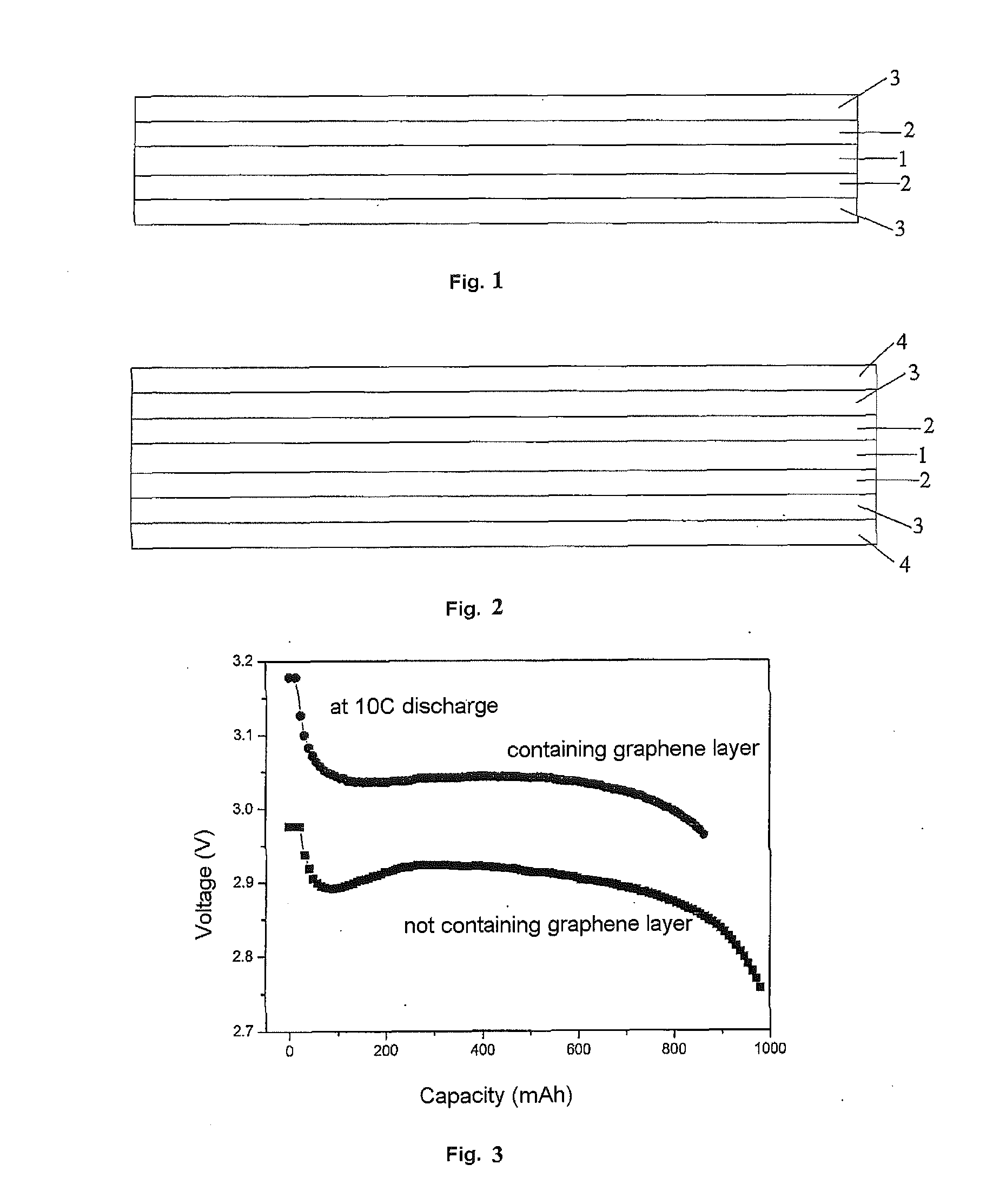Graphene coating modified electrode plate for lithium secondary battery and method for producing the same
a lithium secondary battery and electrode plate technology, applied in the field of energy storage material technology, can solve the problems of providing very limited improvement on the performance of the battery and great difficulty in achieving a further breakthrough, and achieve excellent conductive properties
- Summary
- Abstract
- Description
- Claims
- Application Information
AI Technical Summary
Benefits of technology
Problems solved by technology
Method used
Image
Examples
example 1
Method for Producing the Electrode Plate
[0063]Graphene layers modified LiFePO4 positive electrode plate
[0064](1) 70 parts by weight of graphene, 5 parts by weight of PVDF and 2000 parts by weight of NMP were sufficiently mixed and dissolved to obtain a slurry, the slurry was applied to both surfaces of an aluminum foil, and the coated foil was dried in an oven at 200° C. to obtain an aluminum foil modified with graphene layers. The thickness of the graphene layer on a single side was 3 microns (referred to as the inner graphene layer).
[0065](2) 90 parts by weight of LiFePO4, 5 parts by weight of PVDF, 5 parts by weight of SP and 200 parts by weight of NMP are sufficiently mixed and dissolved to obtain a slurry, the slurry was applied to both surfaces of the aluminum foil modified with graphene layers, and the coated foil was dried in an oven at 80° C. to obtain an electrode plate comprising positive material layers. The thickness of the positive material layer on a single side was 9...
example 2
Method for Producing the Electrode Plate
[0068]Graphene layers modified LiFePO4 positive electrode plate
[0069](1) 98 parts by weight of graphene, 3 parts by weight of PVDF and 2500 parts by weight of NMP were sufficiently mixed and dissolved to obtain a slurry, the slurry was applied to both surfaces of an aluminum foil, and the coated foil was dried in an oven at 80° C. to obtain an aluminum foil modified with graphene layers. The thickness of the graphene layer on a single side was 3 microns.
[0070](2) 90 parts by weight of LiFePO4, 5 parts by weight of PVDF, 5 parts by weight of SP and 200 parts by weight of NMP were sufficiently mixed and dissolved to obtain a slurry, the slurry was applied to both surfaces of the aluminum foil modified with graphene layers, and the coated foil was dried in an oven at 80° C. to obtain an electrode plate comprising positive material layers. The thickness of the positive material layer on a single side was 90 microns.
[0071](3) 98 parts by weight of ...
example 3
Method for Producing the Electrode Plate
[0074]Graphene layers modified graphite negative electrode plate
[0075](1) 89 parts by weight of graphene, 2 parts by weight of PVDF and 2100 parts by weight of NMP were sufficiently mixed and dissolved to obtain a slurry, the slurry was applied to both surfaces of an copper foil, and the coated foil was dried in an oven at 120° C. to obtain a copper foil modified with graphene layers. The thickness of the graphene layer on a single side was 2 microns.
[0076](2) 92 parts by weight of graphite, 5 parts by weight of CMC, 3 parts by weight of KS-6 and 200 parts by weight of water were sufficiently mixed and dissolved to obtain a slurry, the slurry was applied to both surfaces of the copper foil modified with graphene layers, and the coated foil was dried in an oven at 110° C. to obtain an electrode plate comprising negative material layers. The thickness of the negative material layer on a single side was 90 microns;
[0077]The above obtained electro...
PUM
 Login to View More
Login to View More Abstract
Description
Claims
Application Information
 Login to View More
Login to View More - R&D
- Intellectual Property
- Life Sciences
- Materials
- Tech Scout
- Unparalleled Data Quality
- Higher Quality Content
- 60% Fewer Hallucinations
Browse by: Latest US Patents, China's latest patents, Technical Efficacy Thesaurus, Application Domain, Technology Topic, Popular Technical Reports.
© 2025 PatSnap. All rights reserved.Legal|Privacy policy|Modern Slavery Act Transparency Statement|Sitemap|About US| Contact US: help@patsnap.com


